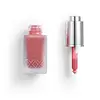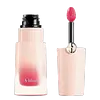What's inside
What's inside
 Key Ingredients
Key Ingredients

 Benefits
Benefits

 Concerns
Concerns

 Ingredients Side-by-side
Ingredients Side-by-side

Isododecane
EmollientIsononyl Isononanoate
EmollientPolybutene
Trimethylsiloxysilicate
EmollientSilica Silylate
EmollientHydrogenated Styrene/Isoprene Copolymer
Phenoxyethanol
PreservativeTocopheryl Acetate
AntioxidantZingiber Officinale Root Oil
MaskingCitrus Clementina Peel Oil
MaskingCinnamomum Cassia Leaf Oil
MaskingPentaerythrityl Tetra-Di-T-Butyl Hydroxyhydrocinnamate
AntioxidantParfum
MaskingLimonene
PerfumingCinnamal
PerfumingEugenol
PerfumingLinalool
PerfumingCitral
PerfumingCI 15850
Cosmetic ColorantCI 15985
Cosmetic ColorantCI 19140
Cosmetic ColorantCI 77491
Cosmetic ColorantCI 77492
Cosmetic ColorantCI 77499
Cosmetic ColorantCI 77891
Cosmetic ColorantIsododecane, Isononyl Isononanoate, Polybutene, Trimethylsiloxysilicate, Silica Silylate, Hydrogenated Styrene/Isoprene Copolymer, Phenoxyethanol, Tocopheryl Acetate, Zingiber Officinale Root Oil, Citrus Clementina Peel Oil, Cinnamomum Cassia Leaf Oil, Pentaerythrityl Tetra-Di-T-Butyl Hydroxyhydrocinnamate, Parfum, Limonene, Cinnamal, Eugenol, Linalool, Citral, CI 15850, CI 15985, CI 19140, CI 77491, CI 77492, CI 77499, CI 77891
Water
Skin ConditioningCyclopentasiloxane
EmollientPhenyl Trimethicone
Skin ConditioningIsononyl Isononanoate
EmollientAlcohol
AntimicrobialPEG-10 Dimethicone
Skin ConditioningGlycerin
HumectantBis-PEG/PPG-14/14 Dimethicone
EmollientVinyl Dimethicone/Methicone Silsesquioxane Crosspolymer
Tocopheryl Acetate
AntioxidantPhenoxyethanol
PreservativeMagnesium Sulfate
Dimethicone
EmollientDisteardimonium Hectorite
StabilisingDisodium Stearoyl Glutamate
CleansingOctyldodecanol
EmollientAlumina
AbrasiveAluminum Hydroxide
EmollientCI 77891
Cosmetic ColorantCI 77491
Cosmetic ColorantCI 77499
Cosmetic ColorantCI 15850
Cosmetic ColorantCI 19140
Cosmetic ColorantCI 15985
Cosmetic ColorantCI 42090
Cosmetic ColorantWater, Cyclopentasiloxane, Phenyl Trimethicone, Isononyl Isononanoate, Alcohol, PEG-10 Dimethicone, Glycerin, Bis-PEG/PPG-14/14 Dimethicone, Vinyl Dimethicone/Methicone Silsesquioxane Crosspolymer, Tocopheryl Acetate, Phenoxyethanol, Magnesium Sulfate, Dimethicone, Disteardimonium Hectorite, Disodium Stearoyl Glutamate, Octyldodecanol, Alumina, Aluminum Hydroxide, CI 77891, CI 77491, CI 77499, CI 15850, CI 19140, CI 15985, CI 42090
Ingredients Explained
These ingredients are found in both products.
Ingredients higher up in an ingredient list are typically present in a larger amount.
Ci 15850 is the pigment color red. It is an azo dye and created synthetically.
Azo dyes need to be thoroughly purified before use. This allows them to be more stable and longer-lasting.
This ingredient is common in foundations, lipsticks, and blushes. This color is described as brown/orangey red.
It has many secondary names such as Red 6 and Red 7. According to a manufacturer, Red 6 usually contains aluminum.
Learn more about CI 15850Ci 15985 is a dye made from petroleum. It is synthetically created and approved by the FDA for use in foods and cosmetics.
The color of this dye is orange/yellow.
This ingredient can be found in makeup, sun care, and skincare.
Learn more about CI 15985CI 19140 is also known as Tartrazine. Tartrazine is a synthetic dye used in cosmetics, foods, and medicine to add a yellow color.
Tartrazine is created from petroleum and is water-soluble.
Some people may experience allergies from this dye, especially asthmatics and those with an aspirin intolerance.
Learn more about CI 19140Ci 77491 is also hydrated iron III oxide. It's sole purpose is to give a red/pink hue to products.
Iron III oxides are classified as inorganic chemicals for coloring.
Synthetically created Ci 77491 is considered safer than those naturally found. This is because the synthetically created version may contain less impurities. Iron oxides are generally non-toxic and non-allergenic.
Learn more about CI 77491Ci 77499 is also hydrated iron III oxide. It is created from mixing red and black iron oxides. This helps give shades of darkness to a product.
Iron III oxides are classified as inorganic chemicals for coloring.
Ci 77891 is a white pigment from Titanium dioxide. It is naturally found in minerals such as rutile and ilmenite.
It's main function is to add a white color to cosmetics. It can also be mixed with other colors to create different shades.
Ci 77891 is commonly found in sunscreens due to its ability to block UV rays.
Learn more about CI 77891Isononyl Isononanoate is a synthetic skin-conditioner and texture enhancer. It is created from nonanoic acid, a fatty acid found in cocoa and lavender oil.
As an emollient, Isononyl Isononanoate helps keep your skin soft and smooth. This is because emollients create a barrier on the skin to trap moisture in.
Isononyl Isononanoate helps give products a velvet feel and improves spreadability.
Learn more about Isononyl IsononanoatePhenoxyethanol is a preservative that has germicide, antimicrobial, and aromatic properties. Studies show that phenoxyethanol can prevent microbial growth. By itself, it has a scent that is similar to that of a rose.
It's often used in formulations along with Caprylyl Glycol to preserve the shelf life of products.
Tocopheryl Acetate is AKA Vitamin E. It is an antioxidant and protects your skin from free radicals. Free radicals damage the skin by breaking down collagen.
One study found using Tocopheryl Acetate with Vitamin C decreased the number of sunburned cells.
Tocopheryl Acetate is commonly found in both skincare and dietary supplements.
Learn more about Tocopheryl Acetate